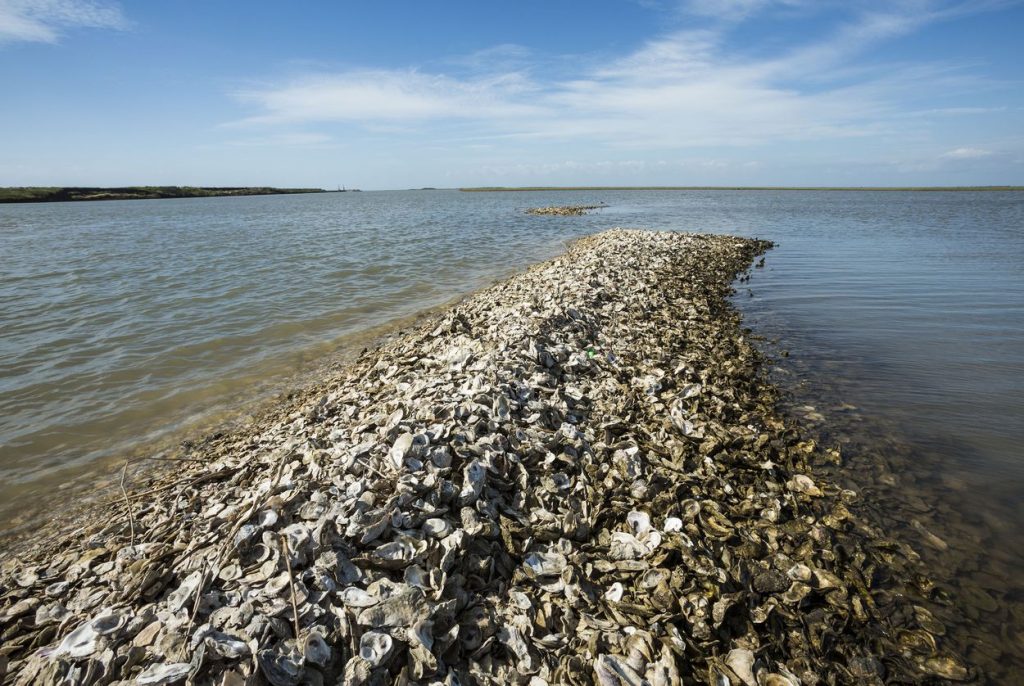
The view from our dock looking at the Cape Romain Wildlife Refuge.

Catching this trout on D.O.A.’s topwater, the PT-7, was the highlight of my trip. Photo: Scott Null
By Kelly Groce
South Carolina is home to 6-8’ tides, incredible seafood and BBQ, miles of marshes and mature oaks draped with moss. I was lucky enough to be able to fish this area with some great people in the fishing industry and the Low Country did not disappoint.
An hour north of Charleston, is the small, quaint community of McCllellanville. Here you will find the marsh land beauty and National Wildlife Refuge, Cape Romain, that separates the ICW from the Atlantic. I was expecting to catch a lot of redfish here, but speckled trout were the ones that showed up to play our first day of the trip. Capt. Jordan Pate has lived in the area his whole life and enjoys everything that there is to offer such as fishing, hunting and surfing. Jordan uses similar tactics we use here in Texas. Jordan had some rods rigged with a popping cork and D.O.A. 3” Shrimp and the other rods had a jighead with a D.O.A. 3” Shad. The wind was howling, but both of these methods worked just fine. Capt. Brian Barrera had to try the D.O.A. 3” Shad in the color Candy Corn since he was told he’d never catch anything on a lure that color in these water. He turned the skeptics into believers.

Charleston is home to great seafood. The oysters were incredible.
The second of the trip, Scott Null and myself traveled into Charleston to fish with Capt. Joe Benton on his Cayo poling skiff. We started the day fishing around some exposed oyster reefs and looking for tailing reds. The waters were calm so it was the perfect opportunity to throw D.O.A.’s topwater, the PT-7. As I was working my PT-7 alongside some grass I got a blow-up pretty close to the boat and it ended up being a beautiful 23” trout. Once again, coming to South Carolina I thought I was going to be catching redfish for the most part, but I’m not going to
complain about catching thick speckled trout on topwaters…ever. We poled around the corner and there was a beautiful sight of shrimp jumping followed by redfish wakes and tails waving. They weren’t amused with my topwater, so Scott got some photos and I enjoyed the nature show. If I would have had the time to change out my lure, a D.O.A. shrimp or their new lure, the Snakoil, would have done the job. Meanwhile on a different boat, Ed Zyak was putting a hurt on redfish using the Snakoil. It is great for sight casting big redfish and trout.
Both days of fishing ended with exchanging fish stories paired with incredible meals. South Carolina’s oysters are un-be-lievable. Shrimp and grits, crab cakes, pulled pork, chicken wings… it’s all good. If you don’t come to South Carolina to experience the fishery, you should definitely make the trip for the cuisine.
Thank you Mark Nichols, Ed Zyak and Brian Barrera of D.O.A. Lures for the invite to experience everything the Low Country has to offer. With fishing gurus such as Bill Carson, Scott Null, Cindy Nguyen, Johnny Lu, Jeff Burleson and Dave Lear in the mix, it’s always a fun few days of learning and laughs.

Capt. Joe Benton and Scott Null heading in after a day of fishing Charleston.

Capt. Brian Barrera with an example that similar tactics we use here in Texas such as a popping cork rigged with a D.O.A. shrimp worked just as good in South Carolina.

My first South Carolina speckled trout. We caught plenty of trout this size using a D.O.A. jighead with a 3″ Shad tail or the 3″ shrimp rigged under a popping cork. Photo: Brian Barrera









